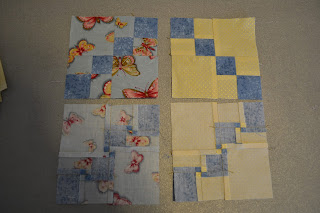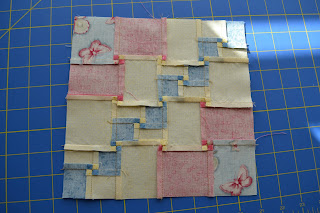Interlacing Circles is a project designed to continue our precision piecing while working on something incorporating almost all the techniques learned to date. Here the pattern looks complicated, yet is simply a combination of rail fence blocks, nine patch blocks, and solid blocks.Here is the sample as shown in our assignment:

This quilt required a dark red, dark pink, paisly, and cream fabric.
My husband and I were out running errands together and I slyly stuck in a trip to JoAnn's. My dh was patient with me last time, and he is good with colors, so I convinced him it was an easy in and out. (hahaha). Well, we couldn't find what we were looking for, or even close, in reds. In the mean time, our cutting number was coming up (because this time, he knew the routine... walk in, go get the number, then start the fabric hunt :) He went over and traded his number for a later number with another man waiting in line :) When our number came up again, and we were STILL not ready, I told him not to worry, they'll work us in anyway..
Back to the fabric hunt. I decided to change to an Orange color scheme when I looked over to a fabric bunched together in another spot and they just looked cheery!
Dh informed me that we still didn't have a good "cream", but I decided I liked the cream with the flowers too much to go plainer. Besides, we couldn't find one with more cream, less color. And, that was my favorite of the bunch!
We hurried over to the cutting counter, and found we were only about 5 numbers behind.... And, the nice lady at the counter worked us in next :)
Turns out when I went to align my fabrics, the light orange felt SO different. I'm hoping it is 100% cotton, but is not tightly woven and is thin, thin, thin. I was worried it wouldn't sew nicely up against the other fabrics. Turns out, it was a bit of a problem. I will have to
Slow Down when in a hurry to get some fabric and move along on the errands!
Making the blocks was simply an exercise in getting it right, because there was nothing really new here. Assembling the top on the board took more time, as the pieces had to be placed just right.
When I got done, I was missing one piece and had an extra of another. I looked carefully, and couldn't see that I had anything wrong, so I cut another rail fence of the one I needed, and started looking again, and THEN saw where I had swapped the pieces. These type of configurations really need several different looks.
Here is a block:
And, here is the finished top sans the border in cream.
Maybe a little busy? But, I think it still works. I didn't lose the circles anyway! Had I gotten a cream color that wasn't so busy, I think it would have been a perfect Orange colorway substitute for the Red.
This week, I've been working on upgrading my quilting space. My little sewing desk isn't big enough to hold up the quilts. I need a place for them to go after they go through the needle. So, I picked up a small 4'x2' folding table at Costco. It will work just fine as a resting place for the piecing and quilting.
I also searched the internet for a cutting table and came up with NOTHING :(
I've currently got a 72"x30" folding table that also folds in half. It is also from Costco a long time ago. I have an issue with the "folding" crack in the middle of the table. It can be felt through the cutting mat, and I am always having to rearrange my fabric to stay away from the hump and crack space.
I must be able to disassemble for when guests come. I was hoping there was some great product or inspiration online, but just couldn't find it. Then, I went to JoAnn's and they had a "craft/hobby" table. Not much info about it on the box, and no display.
They lady reminded me that if I didn't like it, I could return it, no problem. (Must have receipt within 90 days, blah, blah, blah)
I should have checked JoAnn's online. I wonder why this table didn't show up when I did searches?
So, I got it, came home yesterday and spent 2 hrs putting it together. All to find out that it sits on wobbly spindle metal legs with wheels that rock back and forth. Ugh. When I went to look at reviews to see what people said they did to fix it, all I found were 0-2 stars with almost everyone saying that they returned it, wished they returned it, or it broke within months. I could just kick myself. It is so unlike me to not check first. And, although I did consider checking reviews BEFORE I put it together, I decided I wanted to make the decision myself since it was returnable anyway.
My dh got out his drill and the thing was disassembled and restored in the box within 10 minutes!
My chore for the day, to return it. I'm disappointed, because it was the perfect size for the room, could fold down for space saving and rolled so I could move it around in my small space. Oh well. Back to my table on wood blocks with a crack and hump down the middle.
Any brilliant ideas out there?







































.JPG)
.JPG)
.JPG)
.JPG)
.JPG)
.JPG)